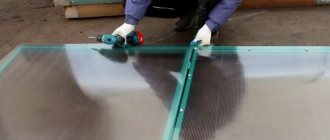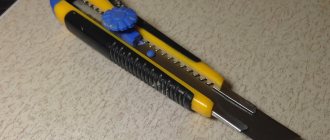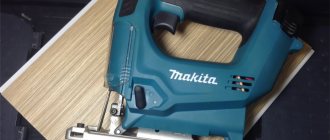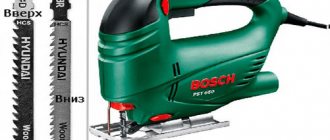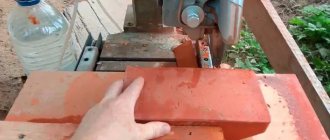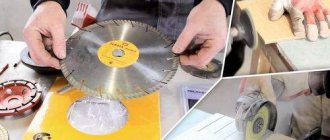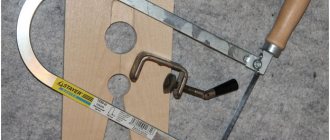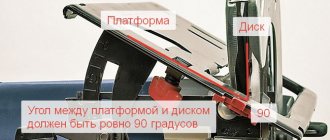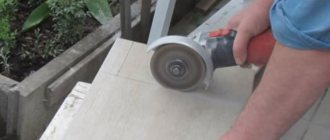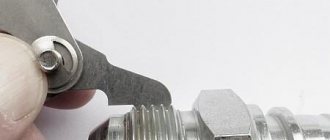What types of plastic aprons are there?
They come in the following materials:
- PVC
- ABS
- Polycarbonate (acrylic glass)
We will not discuss here plastic lining, which has long since become obsolete morally and is not worth a single good word if used to decorate a work wall.
Not only is it simply unfashionable, but also in terms of flimsiness it simply has no equal. You can pierce it with your finger, if you really want! And at high temperatures it melts ungodly. Moreover, it’s enough to heat the wall to 45 degrees and goodbye neat appearance...
And before you make a purchase, giving in to an impulse and falling for a pretty color, it makes sense to ask the seller what their aprons are made of. Because it depends on how long they will serve you and how easy it will be to care for them.
So let's start the analysis.
Review of advantages and disadvantages
The cheapest material for making panels. At the same time, he looks no worse than others, which is the reason for his popularity.
The fact is that plastic panels, in principle, appeared on the market relatively recently and have not yet managed to become “persona non grata” in the kitchen, like the same plastic lining with which everyone has long been familiar.
And so far these panels are selling well, without going into too much detail about what type of plastic is in front of them.
So, PVC is the worst option of all available. We offer you for consideration a table that shows the advantages in one column (which are the trump cards of sellers), and in the second - real explanations for these controversial advantages.
| Pros of PVC | The other side of the advantages of PVC |
| It's inexpensive | Of course it's inexpensive. But if you consider that they are practically disposable, the price will no longer seem so tempting. A plastic “service” can also be used more than once, but this will not turn it into porcelain. PVC aprons are from the same opera: you use them for six months and are happy, and the rest of the time you just endure and get angry: after all, they get scratched from washing and instantly fade. This all means that sooner or later you will have to replace the panel with a new one. And in the case of PVC, sooner rather than later. So consider: is it profitable to buy the same product twice? |
| Easy to clean and has no crevices | Yes, it’s easy, but with one “but”: you must immediately wipe off the greasy drops before they get into the surface and dry out. If the dirt stays for even a little while, it will be difficult to remove them, since the PVC panel should absolutely not be scrubbed with a hard brush or any aggressive substances should be used to dissolve fat. That is, we slightly missed the point - you will have to wash it using prohibited substances, which will lead to instant dulling of the surface. |
| Easy to install with your own hands | This is undoubtedly easy. But it’s better for you to think about how you will remove it after the scratched look gets pretty boring. Considering that the most common option is fastening with liquid nails, the dismantling process will not be too joyful. To then clean the walls from this glue, you will have to use a hair dryer and spend a lot of time. Ordinary cement mortar, on which the tiles are attached, is much easier to break |
Here's an oil painting for you. PVC also has obvious disadvantages:
1. PVC panel is afraid of elevated temperatures. This means that they should not be installed near the stove, for example, as they will certainly melt. So what does this mean? Near the hot zone you need to attach another material or tile. So what is the point then, to use such a coating at all, if it is chosen solely because of its holistic, beautiful design, mainly with photo printing?
2. PVC panel is not environmentally friendly. Particularly not environmentally friendly when heated. But here you need to be fair and take into account the manufacturer. If it is solid, then the level of all sorts of harmful things is normal. But they won’t be very cheap either; at the same time, the other disadvantages of polyvinyl chloride will remain with them: the tendency to abrasion and tarnishing.
How to mount it on the wall?
a kitchen apron yourself. Let's take a look at several ways to secure this finish.
On glue
You can attach a plastic apron using high-quality adhesive. This installation method is rightfully recognized as the simplest and most understandable. Even a beginner can handle its implementation.
In this case, you can use special high-quality glue or good liquid nails for fastening. Of course, it is better to turn to the second option. The glue will need to be applied to the prepared wall base in thin strips, leaving a very small gap between them. After this, the selected plastic panel simply needs to be pressed against the applied adhesive.
The main advantage of this installation method is its simplicity and speed. However, we must take into account that gluing a plastic apron will only work well on a properly prepared base. The wall must be perfectly flat and neat. There should be no traces of the old finish on it. Potholes, irregularities, chips and cracks are also unacceptable.
You will have to get rid of any defects if you want to glue the apron, and not build a sheathing specifically for this. If you neglect this rule and are too lazy to prepare a wall that has uneven surfaces, then you should not expect a long service life from the apron. Soon it will simply stop sticking to this base, even if you spend a lot of glue on it.
READ Be the First to Review This Product
ABS work wall
There are already more advantages here. This coating costs the same as a tile, but is still cheaper than heat-resistant glass. Here are the pros and cons of ABS aprons:
| Advantages of ABS aprons | Disadvantages of ABS aprons |
| Weighs lighter than glass | The plastic has a yellowish tint |
| Abrasion resistant | Will not withstand an iron brush, only light abrasives |
| Resistant to chemicals | If PVC panels cannot withstand even ammonia, then these aprons are only afraid of acetone and solvents, which is also not a plus |
| Eco-friendly | Fades quickly in light |
| Wide variety of textures | There are not many ready-made drawings; more often you have to make an individual order, which also adds to the cost |
Polycarbonate apron
And here are even more advantages! See what we're talking about:
- This panel does not fade
- Not afraid of blows
- Very transparent and indistinguishable from glass
- Fire resistant
But, no matter how sad it is to admit, it scratches just like any plastic. It costs more, yes, but it wears out the same way.
So, as you can see, the results are not very encouraging, no matter what material we consider.
Rules for caring for an apron
The apron should be washed periodically with soap and water using a soft sponge or cloth. Instead of soap, you can use dishwashing liquid, but it may leave streaks if you don’t wash it off well enough. It is better not to use abrasives, and if there is frozen fat, try to soak it with soap. As you use it, you need to make sure that children do not scratch the material, and also prevent its sudden overheating, although expensive panels are quite resistant to this type of damage. You shouldn’t skimp on the quality of the material, because it should serve you faithfully for a long time.
What other parameters should I pay attention to?
The thicker the sheet, the stronger and more expensive it is. But this, nevertheless, does not negate its instability to abrasives.
Leaf shape is also important. It is always better to take a solid one, covering the entire area of the working surface and seal the upper and lower joints with the wall.
If you don’t close them tightly, dampness will get in there and fungus will definitely develop.
For the same reason, you should not take plastic panels in the form of tiles, which are also glued to the wall, but there are uncovered micro-cracks between them.
Customer reviews about plastic apron
Let's be honest, there are very few good reviews on the Internet, and we do not advise you to opt for plastic panels.
Regular tiles will last much longer (what longer, they will last a lifetime!), they are easier to care for and, if desired, you can always find inexpensive and interesting options.
And it won’t be too expensive to call a tiler: you only need to lay a couple of squares. And if you don’t have enough money for glass, then it’s better to completely abandon the idea of decorating an apron in this style.
An imitation is an imitation and it will never become the original, no matter how cute it looks initially. Artificial black caviar also looks like natural caviar until you try it. So it is here: whoever tried it, spits.
And to confirm our words, here is a review from one customer posted online. She was happy with her purchase for just one day!
But again, keep in mind that this was a PVC apron. Acrylics are a little better, of course. But also more expensive!
Moreover, it is even more expensive than ceramic tiles, which will serve you, maintaining their original appearance, until you get tired of them, and a polycarbonate working wall will last about five years, at best. At the same time, in recent years he will look very “tired” and irritate with his sloppy appearance.
If durability is not important to you and you like to change your interior often, then you can take a plastic apron. After 3-4 years, change it and that’s it. So, since this is exactly your case, we suggest you continue reading further.
False panel materials
make an apron in the kitchen from any coating ─ from chipboard to metal, but the functionality of such solutions is quite controversial, because chipboard absorbs moisture and odors too actively, and metal can rust and collapse under the influence of water. To avoid this, it is necessary to choose materials that are resistant to high humidity. This type of metal will be expensive, and it will not fit harmoniously into any interior. plastic remain more affordable and versatile .
- The cheapest and easiest to install option is, of course, plastic . His palette is quite diverse. But it is not advisable to mount inexpensive material near the stove, since when heated it will release toxic substances and melt. You may prefer more durable solutions and install them yourself. Unlike other false panels, PVC is lightweight, which allows it to be glued directly to the wall, which is convenient not only for the apron, but also for the window sill, the space under which can be lined with plastic material. In the photo and in real life, the plastic apron looks like glass.
READ How to properly cut metal with a gas cutter
A product with photo printing looks bright and realistic in the photo. MDF is a fairly functional material that is available in a rich range of colors with a variety of textures and patterns of wood or stone. Various forms of release allow you to select the most convenient solutions: narrow panels or tile products for covering the walls of the dining area, sheet false panel for arranging the apron and window sill area ─ a similar solution can be used underneath it so as not to cut each of the narrow panels that are used to finish other walls. In the photo - an apron made of MDF panels in a modern kitchen
Glass is the most durable of the listed materials for use in the kitchen work area. In the photo in the gallery below, you will see that the design possibilities of glass false panels are extensive. This surface is easy to care for. Fastening glass, although it is more difficult than plastic or MDF, is only because inexperienced people still have a fear of the fragility of such a product. In fact, for the production of glass aprons (with a photo applied, they are called skinali) they use hardened material or triplex, which is durable. The cost of such a false panel will be higher than that made from plastic or regular MDF, but the result exceeds all expectations, especially since installation in any case is easier and faster than laying ceramic tiles.
Catalog of options
Plastic aprons with fruit and berry designs and flowers
Before you start studying photography, I would like to give some theoretical recommendations. Since fruit and berry designs are often very bright and catchy, such aprons will look good only if the main tone of the walls is neutral and the furniture is simple in shape, and not carved classics.
Now look how it looks in the kitchen interior:
And now the example is the opposite. Here people overdid it and as a result the room looks overly colorful:
So, if you want to emphasize the drawing, you should not decorate other elements, otherwise they will not be clearly visible at all and they will not look good. The best option is this:
And the option of a colored kitchen, where the pattern of the apron is matched to match, looks much worse, since in this case there is no emphasis on anything. Neither the furniture “plays” nor the picture.
Plastic aprons with natural textures
In general, imitation of natural textures is not the best solution for coloring plastic panels. They come in both wood and stone motifs. But in any case, it looks extremely unnatural and is not for everyone.
Here is an example of a kitchen where a cut of boards is depicted on the work surface:
And here is an imitation of masonry:
As you can see for yourself, it doesn’t look much like a stone, both upon closer examination and from perspective.
Therefore, we do not recommend that you opt for such options. If you really want a work wall with the look of stone, but you choose plastic because it’s easier to clean, then you can do it differently.
Make real stonework, and cover it on top with a strip of transparent panel, preferably matte.
Plastic aprons with a mirror surface
With the help of mirrors on your desktop, you can wonderfully expand the room. There is one “but” in such panels: every drop will be very visible and you will have to rub it endlessly (and plastic does not like this, as you remember).
This is how it might look in the interior:
Okay, no doubt. But in this case, we still recommend that you install glass mirrors, it will be more durable and reliable.
Installation on the sheathing is a reliable option
This option is suitable for a kitchen that has already undergone several renovations and cannot boast of perfectly smooth walls. In this case, the box will become a frame that will hold the kitchen apron. Why do we need such a frame?
The plastic panel is very lightweight, which means it can warp when exposed to steam or moisture. The box will solve such problems. You can also install lighting under the panel. The apron will look impressive.
To install the wall panel on the box, you will need the following tools:
- Wooden blocks (20-30 cm wide) or metal profile;
- Drill;
- Screwdriver;
- Stapler with brackets;
- Self-tapping screws and dowels (for frame);
- Self-tapping screws (for panels) with a press washer;
- Construction level;
- Pencil or marker, tape measure.
The first thing you need to do is create a place to work. We move the furniture to the apron area. Now we make markings and “try on” the plastic sheets to the wall. You'll need to determine where the base panel will go (it's usually located below the countertop) and where the splashback will end (it can be hidden under cabinets or resting against them). Next we proceed to install the box.
- First we need to secure the strips or profile around the perimeter of the apron. Take the strip and place it on the bottom level (where the bottom panel will be located). Drill the holes with a drill and secure the strip with screws.
- Now install the top panel flush with the top panel. It is clear that the bar should be equal to the width of the apron.
- For reliability, we also attach two slats to the sides and secure them with self-tapping screws. You have a frame. Depending on the size of the kitchen and backsplash, you can attach several more strips. In the center or at a distance of 30 centimeters from each other.
- The next step is to determine the location of the guides, knife holders and various attachments that will be located in the apron area. Mark these places with a pencil and attach the strips here.
- Next we will install the plastic panels. Everything is simple here. The products are fixed with self-tapping screws using a press washer or stapler (if the groove on the panel allows).
- The products are installed in the following sequence: the launch panel is attached first (at the bottom), then inserted into the groove, etc.
READ Assembly of Makita Screwdriver Gearbox
On the picture. Attaching the apron to the profiles
Another installation point. Seams. To camouflage them, you can choose special strips of the same or contrasting color with the plastic sheets.
And one more trick to get perfect seams: when you secure the panels, hit them with a hammer to push them tightly. At the stage of installing the box, a video can help you, where you will study in detail each installation process.
How much does a plastic apron cost for the kitchen?
Different prices. It all depends on the material of manufacture, thickness, type of pattern and manufacturer. The better the parameters, the correspondingly more expensive the product.
We do not recommend that you choose the most expensive options in the hope that such an apron will last a very long time. It won’t last anyway, and there’s no point in overpaying for a brand name. The only thing is that you definitely shouldn’t take a PVC work surface.
Also keep in mind that any individual order of a drawing will cost more than any ready-made one. Therefore, try to find something suitable so as not to overpay for printing.
